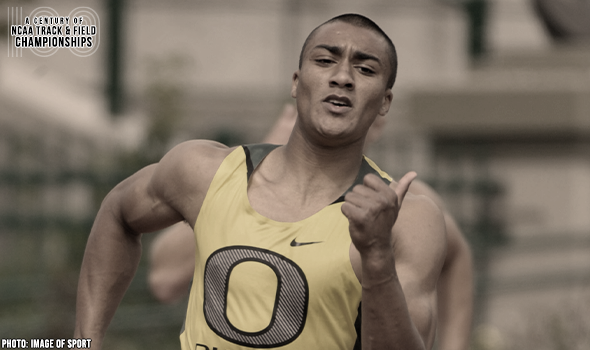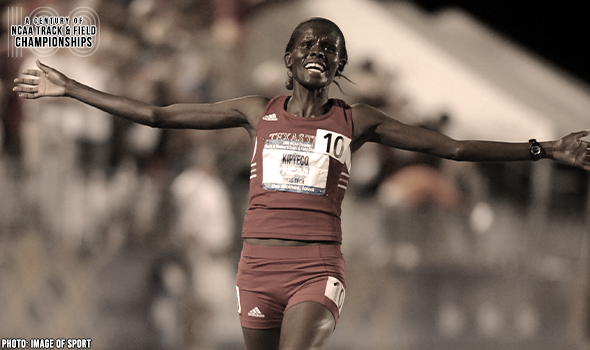
No One Vaulted Like Nilsen At NCAAs
The pole vault has been part of the program at the NCAA Outdoor Track & Field Championships since the beginning. That means for nearly 100 years and 98 installments of the meet, a winner – and sometimes, multiple winners in the case of a tie – has/have been crowned in that event.
No man went higher – or has won by a larger margin of victory – than Chris Nilsen.
The South Dakota standout announced his presence to the collegiate track & field world as a freshman when he won the pole vault at the 2017 NCAA Division I Indoor Track & Field Championships with a clearance of 5.70m (18-8¼). At the time, Nilsen was just the second freshman since the turn of the century to top the podium (Andrew Irwin of Arkansas, 2012).
After a pair of top-3 finishes at NCAA meets, Nilsen tasted victory once again at the 2018 NCAA Division I Outdoor Track & Field Championships inside Historic Hayward Field.
As the rest of the field whittled itself by attrition – all but four men were out by the fourth bar (5.55m/17-10½) – Nilsen only got stronger. Nilsen cleared that aforementioned height on his second attempt to become the de facto winner and then didn’t miss another bar until after he broke Lawrence Johnson’s 22-year-old meet record by one centimeter with his first-attempt clearance of 5.83m (19-1½). That also gave Nilsen a 28-centimeter (11-inch) victory, a margin that matched the previous meet best established by Bob Seagren of Southern California 51 years earlier.
A worthy adversary joined the collegiate ranks the following year and pushed Nilsen to new heights at the NCAA Championships: Mondo Duplantis of LSU. After Duplantis broke the collegiate indoor record and won the NCAA Indoor crown, he and Nilsen were set for an old-fashioned Texas shootout at the outdoor championships hosted by the University of Texas.
Duplantis came in as the favorite once again, having broken the collegiate outdoor record just a few weeks earlier, but Nilsen didn’t back down. Both Duplantis and Nilsen cleared 5.80m (19-0¼) and passed on the next height, which meant they both would attempt 5.90m (19-4¼). A first attempt clearance by Nilsen put pressure on Duplantis, who missed and forwent his final two tries to meet Nilsen at 5.95m (19-6¼). Nilsen went up and over on his first attempt once again to better his own meet record; Duplantis was unable to match.
It’s safe to say Nilsen was on the right track once again in 2020 as a senior, where he sought to become just the fourth man in the past 57 years to win three consecutive pole vault titles at the outdoor championships, joining Dave Roberts of Rice from 1971 to 1973, Earl Bell of Arkansas State from 1975 to 1977 and Istvan Bagula of George Mason from 1990 to 1992.
Back in February, Nilsen broke Duplantis’ collegiate indoor record with his 5.93m (19-5½) topper at the Nebraska Tune-Up and eyed an even bigger jump at the NCAA Indoor Championships, as well as during the ensuing outdoor campaign where the Kansas City, Missouri, native traditionally shined. None of those ever came to be as the COVID-19 pandemic wiped out the rest of the indoor and outdoor seasons.
The NCAA and collegiate track & field will mark a momentous milestone in the spring of 2021 -- the 100th anniversary of the NCAA Championships and with that, the NCAA Track & Field Championships. In June 1921, the University of Chicago hosted the first track & field championships in NCAA history.
This point can’t be emphasized enough: Not only was the event the first for NCAA track & field, but the first championships for any sport under the sponsorship of the NCAA.
To celebrate, over each of the next 365 days, the U.S. Track & Field and Cross Country Coaches Association (USTFCCCA) will celebrate moments, student-athletes, and coaches that have made a century’s worth of championships special. From humble beginnings to important historical milestones to the modern-day, collegiate track & field has evolved with the American society.
The 2021 edition of the NCAA Division I Outdoor Track & Field Championships begin with preliminary round action on May 27-29 in Jacksonville, Fla., and College Station, Texas. The championships final site and culmination of the celebration is slated for June 9-12, 2021 at the newly rebuilt Hayward Field in Eugene, Ore.

Hornbostel Left Mark As A Hoosier
Chuck Hornbostel of Indiana won three consecutive 800/880 titles between 1932 and 1934 and equaled the world record in the 880 yards in 1933.

BYU’s Mann Set World Record In 440 Hurdles
Ralph Mann of BYU won three consecutive NCAA titles in the 440 Hurdles and set a world record with his win in 1970.

Auburn’s Goulbourne Makes Long Jump History
Elva Goulbourne of Auburn became the first – and remains the only – woman to repeat as long jump champion at the NCAA Division I Outdoor Track & Field Championships in 2002 & 2003.

LoJo Breaks Barriers, Records In Pole Vault
Lawrence Johnson of Tennessee won back-to-back pole vault titles at the NCAA Division I Outdoor Track & Field Championships with some of the largest margins of victory in meet history.

Smith Set Records That Will Last Forever
Karin Smith of Cal Poly won the javelin crown at both the 1982 NCAA Division I & NCAA Division II Outdoor Track & Field Championships with meet records that will never be broken.

KU’s Cunningham Captures 1500/Mile Twice
Glenn Cunningham of Kansas was the first two-time winner of the 1500/mile at the NCAA Outdoor Track & Field Championships.

Rollins Rewrites Hurdling History
Brianna Rollins capped an incredible senior season at the 2013 NCAA DI Outdoor Track & Field Championships with the two fastest times in collegiate history in the 100 Hurdles.

Oregon’s Eaton Stood Alone In The Decathlon
Ashton Eaton set a meet record for both point total and scoring margin at the 2010 NCAA Division I Outdoor Track & Field Championships.

Texas Tech’s Kipyego Redefined Success
Sally Kipyego of Texas Tech set a still-standing meet record of 15:15.08 in the 5000 Meters at the 2008 NCAA Division I Outdoor Track & Field Championships.

“Heavenly Twins” Reach New Heights In Pole Vault
Bill Sefton and Earle Meadows of Southern California rewrote the record book in the pole vault during an electric 1937 season.

